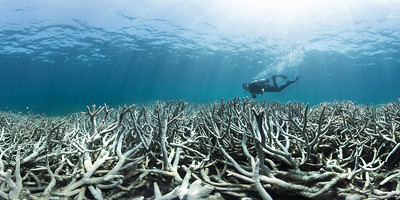Climate change is the greatest global threat to coral reef ecosystems.
As temperatures rise, mass coral bleaching events and disease outbreaks are becoming more frequent. Additionally, carbon dioxide absorbed into the ocean from the atmosphere has already begun to reduce calcification rates in reef-building and reef-associated organisms by altering seawater chemistry through decreases in pH. This process is called ocean acidification.
Climate change will affect coral reef ecosystems, through sea level rise, changes to the frequency and intensity of tropical storms, and altered ocean circulation patterns. When combined, all of these impacts dramatically alter ecosystem function, as well as the goods and services coral reef ecosystems provide to people around the globe. Coral reefs are especially vulnerable to climate change.
Coral reefs are projected to lose between 70 and 90% of their former coverage area at 1.5 °C of warming and over 99% at 2 °C (UNEP 2021)

Coral bleaching poses a major threat regarding:
Biodiversity loss:
corals shelter and sustain a huge diversity of marine wildlife that rely entirely on them for their survival, as well as for other animals related to them downstream in the food chain.
Food security:
large human populations depend on marine resources to sustain their livelihoods. Impacting coral reef ecosystems poses a threat them, but also for others who benefit indirectly from them for tourism and other economic activities.
Security:
Coral reefs are natural barriers that absorb the force of waves and storm surges, keeping coastal communities safe. Without them, we must rely on manmade seawalls that are expensive, less effective, and environmentally damaging to construct.
Source: WWF.
